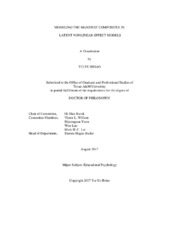| dc.description.abstract | Estimating nonlinear effects, including interaction and quadratic effects, is a prevailing issue in social and behavioral science. Despite several advantages of using latent variable models in estimating nonlinear effects, conducting path models with observed composites is still a very common practice among applied researchers. However, it is well-known among methodologists that conducting path models without considering the measurement errors of the observed composites would lead to biased estimation. Hence, the aim of this dissertation is to bridge the gap between methodologists and applied researchers by reviewing two methods— reliability adjusted product indicator (RAPI) and latent moderate structural equations (LMS)—which can be applied for estimating nonlinear effects while accounting for the measurement errors of the composites.
The dissertation is composed of three manuscripts. In the first manuscript I reviewed the RAPI and LMS methods and compared their performance with the conventional path models in terms of the estimation accuracy of the interaction effects. The second manuscript focuses on choosing the most appropriate reliability estimates while conducting the RAPI and LMS methods. In the third manuscript I discuss issues regarding having both interaction and quadratic effects in the models, and the impact of multicollinearity of the exogenous variables on the estimation of both nonlinear effects.
Based on the simulation results, I found that while estimating nonlinear effects with observed composites, conduct latent variable models and apply both the RAPI and LMS methods yielded more accurate interaction estimates than the conventional path analysis. Additionally, for items following congeneric assumption, applying the RAPI and LMS methods with the Revelle’s omega total yielded more accurate results; if only the power of the test is of interest, applying Cronbach’s alpha, omega, and GLB make less difference. However, caution should be made for applying the RAPI and LMS methods when the correlation between the latent exogenous variables are high (i.e., over .5), especially when both interaction effects and quadratic effects are of interest. This dissertation concludes with a summary of findings and the implications of these findings in applied research. | en |


